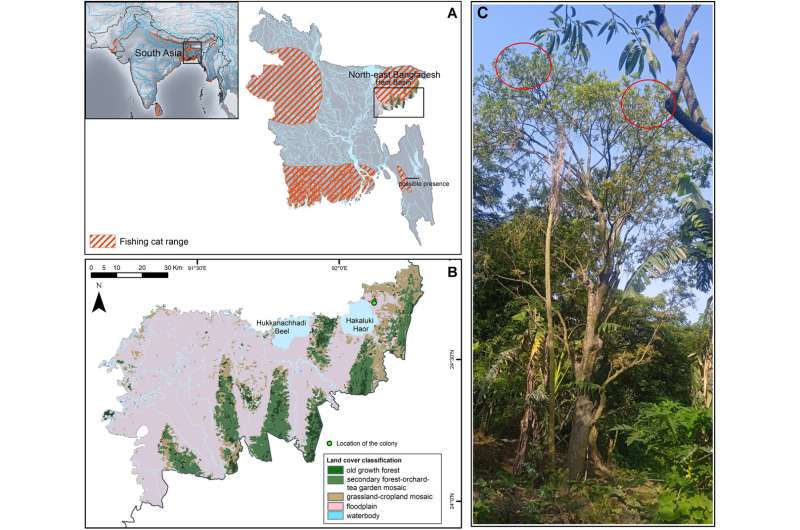This article has been reviewed according to Science X's editorial process and policies. Editors have highlighted the following attributes while ensuring the content's credibility:
fact-checked
trusted source
proofread
Asian fishing cats caught snacking on chicks from tree-top nests

South Asian fishing cats were observed raiding bird nests in tall trees for the first time. This rare and highly unusual behavior was caught on motion cameras set up in tree canopies across northeast Bangladesh to survey bird colonies. Scientists hope this unexpected finding, published in the De Gruyter journal Mammalia, will help piece together the ecology of these elusive felines and contribute to conservation efforts.
Assistant Professor Muntasir Akash of the University of Dhaka, Bangladesh, and colleagues studied around 282 days of footage captured by unbaited passive infrared cameras operating 24 hours a day. The study is published in Mammalia.
Nineteen still images showed nighttime predation by fishing cats (Prionailurus viverrinus) on two different multi-species bird colonies; this included a fishing cat biting the neck of a little cormorant (Microcarbo niger) chick in a nest in the canopy of an 8m-tall Indian Oak tree (Barringtonia acutangular). "That is a pretty high tree for a fishing cat," says Akash, recalling his surprise at seeing the predator where no-one had seen it before.
Fishing cats have water-resistant fur over two layers, as well as semi-retractile claws and partially webbed forepaws to hunt their prey, about three-quarters of which is river fish. However, despite their name and biological specializations for a fish-eating diet, fishing cats still retain many typical feline features.
"Their dentition, except for the large premolars to grip any slippery prey, is of general felid structure," says Akash. "And their semi-webbed forepaws are no more webbed than those of a bobcat."
Retention of these basic feline characteristics could give them an advantage when surrounding areas flood during the monsoon season. Until now, it was a mystery how fishing cats could survive when their foraging habitat completely flooded. Being able to hunt birds in the tall arboreal canopy could provide shelter and food resources when the monsoon makes fishing difficult, dangerous or impossible.
Fishing cats are so adept at catching river prey that they are frequently driven away from fertile fishing areas and hunted by humans who consider them dangerous or competitors for food.
"Monitoring of media reports on human–fishing cat conflicts suggests that a fresh conflict is happening in the country every two weeks," says Akash. "Conservation efforts targeting fishing cats should thus be prioritized and all options for effective mitigation scientifically assessed."
In addition to human pressure, destruction of wetlands threatens fishing cat populations around Southeast Asia and the species is currently rated Vulnerable on the International Union for Conservation of Nature Red List of Threatened Species.
The cat might have an unknown dependency on the wetland bird colonies that are vulnerable to hunting and tree felling, Akash says, "A stable population of wetland bird colonies might be a win-win for the wetland, fishing cats and the local people who depend on the wetlands."
More information: Allama Shibli Sadik et al, A treetop diner: camera trapping reveals novel arboreal foraging by fishing cats on colonial nesting birds in Bangladesh, Mammalia (2024). DOI: 10.1515/mammalia-2023-0074
Provided by SciencePOD




















